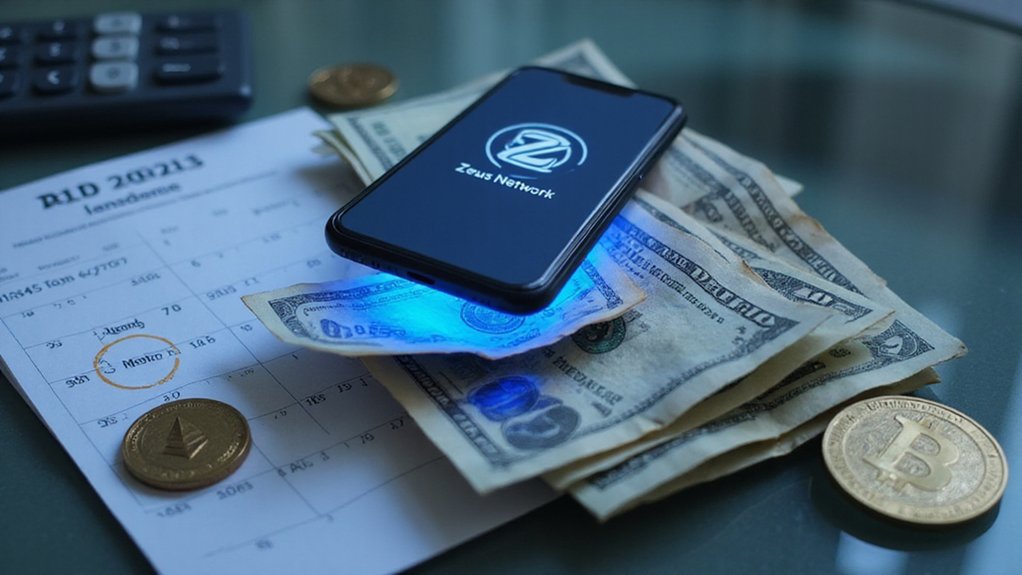RLUSD is Ripple’s regulated stablecoin maintaining a precise 1:1 peg with the US dollar—fully backed by cash and cash equivalents held in segregated accounts. Issued by Ripple subsidiary Standard Custody & Trust Company, this digital asset operates across both XRP Ledger and Ethereum blockchains, processing transactions for mere fractions of a cent. With New York regulatory approval and nearly $250 million in market capitalization, RLUSD represents Ripple’s calculated entry into the increasingly crowded stablecoin ecosystem. The technical architecture reveals much about Ripple’s broader ambitions.

What exactly transpires when a blockchain company known for revolutionizing cross-border payments ventures into the increasingly crowded stablecoin arena?
In Ripple’s case, the result is RLUSD—a dollar-pegged digital asset that has quietly amassed nearly $250 million in market capitalization since its relatively recent debut.
This isn’t merely another entrant in the stablecoin derby; it’s a calculated move by a company with extensive payment infrastructure already in place.
RLUSD operates under a straightforward premise: a 1:1 peg to the US dollar, fully backed by segregated reserves of cash and cash equivalents.
RLUSD maintains uncompromising stability through its dollar-for-dollar backing, with reserves held separately in liquid, readily convertible assets.
The token’s issuer, Standard Custody & Trust Company, LLC—a Ripple Labs subsidiary—provides the institutional gravitas necessary in today’s regulatory climate.
Unlike some competitors whose reserve practices invite scrutiny, RLUSD enters the market with the New York State Department of Financial Services’ blessing, a credential that speaks volumes to institutional adopters.
The stablecoin’s dual blockchain presence—native support on both XRP Ledger and Ethereum—positions it strategically at the intersection of enterprise adoption and DeFi integration.
This technical versatility enables RLUSD to function seamlessly across various use cases, from cross-border treasury operations to collateralizing tokenized real-world assets (a market segment whose potential remains largely untapped).
For enterprises already utilizing Ripple’s cross-border payment solutions, RLUSD offers a logical extension—instant settlement capabilities with near-global coverage through the company’s extensive payout network. Users can enjoy the convenience of near real-time settlement worldwide with minimal fees, eliminating traditional banking delays.
The efficiency gains are substantial; transactions that once required days now conclude in seconds, with compliance frameworks built directly into the infrastructure.
With transaction costs of approximately $0.0002 on the XRP Ledger, RLUSD offers one of the most cost-effective stablecoin solutions in the market.
Leveraging the same consensus protocol that enables Ripple’s rapid transaction validation, RLUSD transactions can be processed without the energy-intensive mining required by other cryptocurrencies.
Currently, RLUSD availability spans several major exchanges—Kraken, LMAX Digital, and Bitstamp among them—though jurisdictional restrictions apply.
The stablecoin’s trajectory suggests a methodical expansion strategy: begin with select enterprise customers, establish credibility through regulatory compliance, and gradually increase accessibility for retail participants.
In a market where stablecoin contenders appear monthly, RLUSD’s institutional approach—focusing on regulatory conformity before aggressive expansion—may prove the wiser long-term strategy.
Frequently Asked Questions
How Does RLUSD Compare to Other Major Stablecoins?
RLUSD distinguishes itself from competitors like USDT and USDC through its dual-chain issuance on both XRP Ledger and Ethereum—offering cross-chain flexibility that others lack.
Where RLUSD truly shines is in transaction economics: XRPL’s 3-5 second settlements and negligible fees ($0.0002) outperform Ethereum-native stablecoins.
While maintaining the industry-standard 1:1 USD backing with third-party audits (like USDC), RLUSD leverages Ripple’s established ecosystem and regulatory approach to potentially capture institutional attention.
Can Individuals Directly Mint or Redeem RLUSD?
No, individuals cannot directly mint or redeem RLUSD.
Unlike some decentralized stablecoins, RLUSD maintains a centralized issuance model controlled by Standard Custody & Trust Company (Ripple’s subsidiary).
The minting privilege is reserved for authorized entities—typically financial institutions that meet stringent compliance requirements.
Redemption similarly occurs through approved custodians and exchange partners, where retail users must rely on third-party services like Kraken or Bitstamp to convert their holdings to fiat currency.
What Are the Potential Regulatory Challenges for RLUSD?
RLUSD faces a labyrinth of regulatory hurdles: jurisdictional fragmentation creates a compliance patchwork that varies dramatically across borders; the evolving regulatory landscape for stablecoins remains in flux (what’s compliant today might not be tomorrow); maintaining cross-border compliance drives operational costs skyward; and the looming threat of restrictive government policies hangs like Damocles’ sword.
The stablecoin must navigate these waters while competing with established players in a market where regulatory certainty remains—perhaps ironically—the most unstable variable.
How Will RLUSD Affect Xrp’s Value?
RLUSD may create a complex interplay with XRP’s value.
While the stablecoin could enhance the broader Ripple ecosystem’s utility (potentially lifting XRP by association), it might simultaneously cannibalize certain XRP use cases.
The complementary yet competitive relationship suggests RLUSD could drive institutional adoption of Ripple’s infrastructure while relegating XRP to more specialized cross-border liquidity functions.
This functional bifurcation might ultimately redistribute rather than diminish XRP’s market value.
Which Exchanges and Wallets Currently Support RLUSD?
RLUSD is currently supported by several major exchanges, including Kraken, Bitstamp, LMAX Digital, Zero Hash, and Bullish.
On the wallet front, it’s accessible through XRP Ledger-compatible wallets, Ethereum-compatible wallets, enterprise wallets linked to Ripple’s custody subsidiaries, wallets integrated with Ripple Payments, and custodial solutions from Ripple partners.
This dual-blockchain compatibility (XRP Ledger and Ethereum) greatly broadens RLUSD‘s accessibility, giving it an infrastructural edge in the increasingly crowded stablecoin marketplace.









